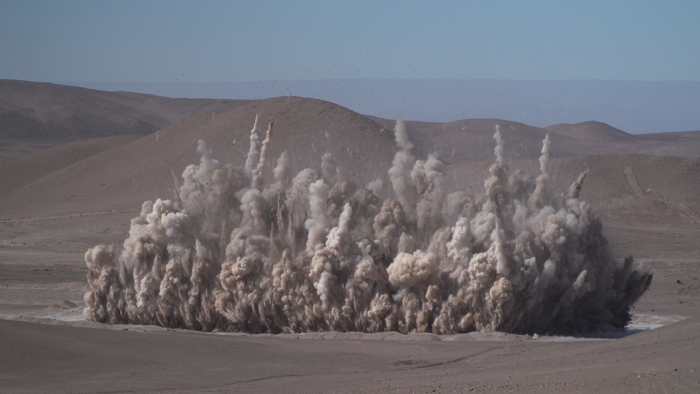I cheated for this assignment. I asked around, both friends and acquaintances in the city, about great, or just-OK, but discourse-altering shows that occurred this year, and without much nudging, we all arrived at the same desolate mental bus stop: no, there weren’t really any that we could think of. The year in Mexican art went almost unremarked. This doesn’t mean that the habitual reviews didn’t go out, that the blockbuster exhibitions went unvisited, that new platforms for art commentary weren’t launched, but perhaps that we in the art crowd had heavier things on our minds (funding issues, that’s what the things were) when we got together.
I was impressed, however, by Melanie Smith’s Farce and Artifice, a major solo show travelling from MACBA in Barcelona to MUAC in Mexico City and Museo Amparo in Puebla, and taking place in both institutions simultaneously. It showcased Smith’s production in a meandering way, the MUAC leg going back and forth in time: from the simulated museum-backroom installation of Irreversible/ Illegible/Unstable (2012), to the Atacama Desert in the video María Elena (2018), and back to the Amazonian jungle with the sculptures, paintings and videos of Fordlandia (2014). In both videoworks, created in Chile and Brazil respectively, Smith seductively uses rapid closeups and pans to create a feeling of disconnected and chaotic forward movement. And although impressive, the collection of so many of her works in a single place revealed some of its blind spots. When dwelling on landscapes, plants and animals, Smith is quick to articulate an enjoyable surface-level sensuality, but when she lingers on the brown skin of bus passengers unaware that they’re being filmed, or on the bodies of fishermen and their children, the imagery tilts slightly towards the exploitative. The same can be said for the work that gives the show its title: Farce and Artifice (2006), in which a nonwhite Cuban man teaches an Anglo-Saxon woman Salsa moves. The woman, of course, is a stand-in for the challenges and complexities of getting around in Latin America as an outsider, a narrative that mimics Smith’s experiences as a British transplant living in Mexico, albeit for decades now, but one that seems purposefully to neglect the real emotional labour local people do to accommodate her and her ex-pat peers.

Also noteworthy was Los huecos del agua. Arte actual de pueblos originarios (The holes in the water: current art from original peoples) at Museo Universitario del Chopo. The sprawling show intelligently pulled away from folklore and idealisation, and in doing so it joined a current of exhibitions taking place in Chile and Peru that effectively integrate the artistic languages and political discourses of these indigenous communities into contemporary art. The show’s curator, Itzel Vargas Plata, gave a platform to the different worlds, the diverse nations that exist under the unified Mexican territory, and to the importance of letting difference thrive and of refusing assimilation; and so the artists tackle the appropriation of their territories, the degradation of their natural resources and the defence of their languages among other urgent subjects. In his piece, Oaxacan artist Andy Medina denounces the way in which the state imposes Spanish on indigenous communities through public education. Although there’s no official tongue in Mexico and there are 68 recognised indigenous languages in use, the government enforces their rapid disappearance with a public-school system designed for Spanish speakers only. Titled LII QUI GANNALU’/IGNORANTE (2016), the installation includes the Zapoteco words for ignorant, lii qui gannalu’, painted on a wall, a school desk directly facing the statement, one of its legs sawed off and supported by a stack of books: the Mexican Constitution, a Spanish dictionary, a Spanish–English one, a book on Mexico’s role in globalisation.
No, perhaps the most discussed issue this year was the new Mexican government, ‘la 4T’ or Fourth Transformation, as they have taken to calling themselves. This entrant leftwing government, which we had all hoped would bring respite from years of misappropriated state funds and corruption, almost immediately launched into punishing austerity, firing tens of thousands of government employees and underfunding many departments. It turned out that well-intentioned ‘republican austerity’ was just as terrible as centre-right, greed-fuelled austerity. At the end of last year, weeks after coming into power, they dealt a huge blow to artworkers by announcing a reduction of 500 million pesos (£20.5m) in state funding for culture. This was followed by attacks on FONCA, the National Fund for Arts and Culture, made by official-party senator Jesusa Rodríguez, and a segment mocking artists on state-sponsored TV. In both, art and culture were painted as the hobbies of the bourgeoisie, an oft-parroted claim that of course only works to make even more invisible those in the Mexican art scene who do not come from money or power. Perhaps my personal highlight of the year was Sandra Sánchez’s article on this whole issue, ‘Pueblo es lo que falta, lo que hay que construir’ (‘A people is what’s missing, what needs to be built’), published on arts website GASTV in June. In it she quotes the academic Salvador Gallardo Cabrera’s warning against the dangers of considering one culture elitist and another ‘for the people’, and how this can lead to oversimplification, the flattening and dumbing down of culture, and at worst, propaganda. The idea of a people is a myth that we might work towards: because if it exists now, if we are – as the state is prone to fantasise – already a solid, cohesive, immutable collective, then we are, likely, fucked.
This article originally appeared in the November 2019 issue of ArtReview
